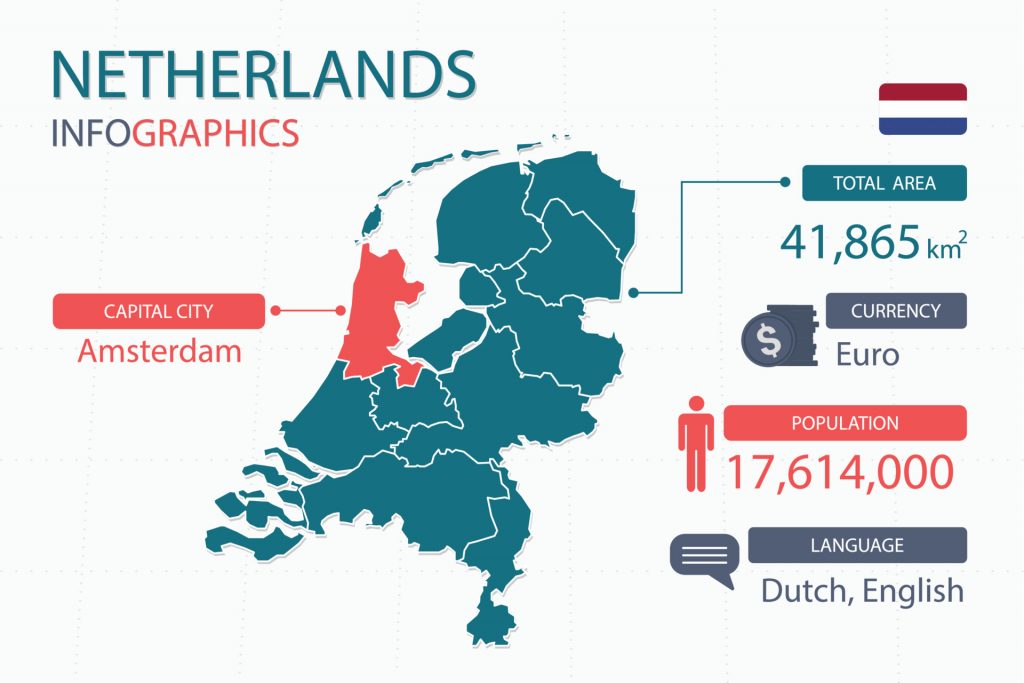The origins of the Dutch Language
Dutch is a language in the Netherlands and Belgium, commonly referred to as the Low Countries. It is also spoken outside of this region in Suriname, being the native language of the population who lives there. It also holds official status in Aruba, Curacao and Sint Marteen, islands in the Carribean. Overall, 24 million people speak it as a first language. In addition, it also has given birth to a “daughter language,” Afrikaans, which is primarily spoken in Southern Africa. In addition, a small trivia fact is that Dutch was the first language of the eighth President of the United States, Martin Van Buren.
Dutch can be considered to have the closest relations with both German and English, and all three are considered West Germanic languages. Unlike English, but like German, there is a grammatical gender classification for nouns which includes masculine, feminine, and neuter groups. It is also similar to German in terms of word order, where order can vary in some clauses depending on what type it is.
Being a Germanic language, much of its core vocabulary is Germanic in origin. However, there is also a heavy French influence due to historical circumstances and cross-cultural contact. There have also been influences stemming from Latin, and most recently, English.

Dutch is written using the Latin script, with the addition of one letter, IJ/ij; it is considered one letter. Other marks include a dieresis, which are two dots above a letter, which is similar to the German umlaut; in Dutch, it is called a trema. Like almost all languages that use a Latin script, it is written left-to-right. The punctuation used is also very similar to these other languages. There is an institution regulating official spelling between Dutch speaking countries.
As mentioned above, it is historically related to English and German, as well as other Scandinavian languages. These include other Western Germanic languages such as Old Frankish, spoken by the Franks, a Germanic tribe. Scholars believe Dutch to have roots in Old Frankish.
The first phase of the history of Dutch is called Old Dutch, which can be classified between the 6th and 11th century. First records of Old Dutch date back to 510 AD. In fact, the oldest sentence in Dutch has been identified by linguists: Maltho thi afrio lito. This was a statement used by feudal lords to free a serf and literally means, “I declare, I free you, half-free.” Half-free was a term used to refer to serfs at the time. This sentence existed in the Salic law code, which contained a number of Old Dutch phrases.
The next iteration of Dutch is named Middle Dutch. It is not conceptualized by linguist as being one language, but rather a group of closely related dialects which were prominent in the present day Dutch-speaking region from 1150 to 1550. at this time, an overall standard language had not yet formed, but this group of dialects were all mutually intelligible. The dialects are classified by linguists into five large groups: Brabantian, Flemish, Hollandic, Limburgish, and Low Saxon.
The latest iteration of Dutch is appropriately called Modern Dutch. Dutch started exhibiting signs of standardization during the middle ages, especially under the influence of the Burgundian Ducal Court based in Dijon, which later was known as Brussels after 1477. This standard was primarily based on the dialect spoken in Flanders and Brabant. In the 16th century, the Brabantic dialect of Antwerp started to become the more influential form that would shape Dutch today. In 1585, during the Siege of Lier near Antwerp by the Spanish army during the Anglo-Spanish War, many people in the region fled to Holland to escape possible negative repercussions by Spanish troops. As a linguistic consequence, the Dutch language in Holland was heavily influenced by the variety spoken by the people who eventually settled in the region.
Since then, linguists believe little evolution has occurred, with most of the language stabilizing. In Belgium and Luxembourg, the language is also referred to as Flemish. However, the Dutch language spoken in these regions are very similar to that of the Netherlands, where there are only slight pronunciation differences, comparable to the difference between British English and American English. In addition, the Language Union Treaty between Dutch speaking countries was established in 1980, making sure that any language development and language policies are developed with overall Dutch language spoken in all countries being kept in mind. Much importance is placed specifically on the common spelling system.
Now, in addition to the countries mentioned above, Dutch is used in a variety of other places as well. For example, a number of law codes in Indonesia are still in Dutch. Interestingly, administrators in former Dutch colonies did not support language-expansion policies, which would have made Dutch official languages in public realms such as education; they were afraid that such endeavors would have destabilized their colonies because native populations might have seen it as an attempt to subvert their respective cultures. In Suriname, however, Dutch is the sole official language, being used as the language of administration, education, and media. And in South Africa, while Afrikaans is not considered to be the same language, but rather as one that stemmed from Dutch, speakers of Dutch can get by as tourists as the two languages are highly mutually intelligible.
VEQTA can provide you with a perfect Dutch translator for your Dutch translation, English to Dutch translation and Dutch to english translation for the your targeted locale. Our translations to Dutch are created with your target audience in mind to meet your expectations.
If you need to translate Dutch – Get in touch today!
A dedicated team of Dutch translators who combines Experience, Specialized Subject Matter Expertise with Translation Practices to deliver quality second to none.
Dutch Subject Expertise
Dutch Translators
Dutch Editors
Dutch Copywriters
Dutch Reviewers
Dutch Voice dubbing
Dutch Subtitling
Dutch Transcription


